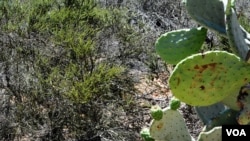The slimy guts of cacti can purify contaminated water, according to researchers at the University of South Florida, who presented their work at the meeting of the American Chemical Society in San Diego.
Norma Alcantar, associate professor of chemical engineering at USF, says the mucilage, or guts, of the cactus, has cleansing properties. It "attracts sediments, bacteria and other contaminants," she explained, so they can be removed from the water. She has been experimenting with the substance for a decade, using it successfully to clean contaminated drinking water after the 2010 earthquake in Haiti. She and her team also have found it to be an effective oil dispersant.
Alcantar learned about the process from her Mexican grandmother, who used boiled prickly pear cactus to pull sediment particles from dirty water, making it drinkable. Cacti are common around the world, so they are a sustainable product, as well as being non-toxic, biodegradable and low cost.
Her lab is now investigating how cacti could help the aquaculture industry. The recirculating systems in fish farm tanks and ponds can create unpleasant tastes and odors in the fish, due to a buildup of bacteria and sediment. Alcantar's research is focused on how an extraction of cactus mucilage could degrade the smelly compounds.
Her team also is studying the chemical composition of the mucilage, which is made up of carbohydrates and about 60 sugars, hoping to eventually synthesize it in a lab.






